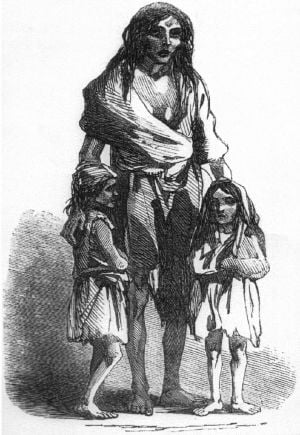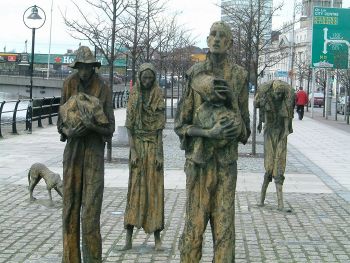Irish Potato Famine (1845–1849)
The Great Famine or the Great Hunger (Gaelic: An Gorta Mór or An Drochshaol), known more commonly outside of Ireland as the Irish Potato Famine, is the name given to the famine that occurred in Ireland between 1845 and 1849. The famine was due to the appearance of "the Blight" (also known as phytophthora)—the potato fungus that almost instantly destroyed the primary food source for the majority of the island's population. The immediate after-effects of the famine continued until 1851. Much is unrecorded, and various estimates suggest that between five hundred thousand and more than 1 million people died in the years 1846 to 1849 as a result of hunger or disease. Some 2 million refugees are attributed to the Great Hunger (estimates vary), and much the same number of people emigrated to Great Britain, the United States, Canada, and Australia.
The immediate effect on Ireland was devastating, and its long-term effects proved immense, permanently changing Irish culture and tradition. The Irish Potato Famine was the culmination of a social, biological, political, and economic catastrophe. In the colonial context of Ireland's domination by Britain, the root cause of the famine was perceived by many to be British policy, which reduced the amount of land available for feeding the Irish, and therefore stimulated the demand for political autonomy.
Irish landholdings
The famine was the product of a number of complex problems which affected nineteenth century Ireland. One of the most central problems was the nature of landholdings. Since the Norman invasion in 1169, Irish ownership of land had been in decline. However, the assimilation of the Hiberno-Normans into Irish society rendered this land transfer of less importance by the end of the sixteenth century. Then, under Mary and Elizabeth, plantations of the country were undertaken. These plantations—in Laois, Offaly, and Antrim respectively—did not survive. Landholding was, however, fundamentally altered by the Plantation of Ulster and the consequences of the Cromwell's conquest of Ireland.
The practice of consolidation of lands into large estates was widespread in Europe, but in Ireland, it was complicated by the discriminatory laws applied to all faiths, in particular against Presbyterians and Roman Catholics. By the time of the Great Hunger these discriminatory laws had been repealed, but not before irreparably biasing large land ownership to non-native, and often non-resident, landlords.
The local practice known as “subdivision”—whereby lands and property were divided equally among male heirs, instead of being inherited by the first-born son (primogeniture)—meant that over each generation the size of a tenant farm was reduced, as it was split between all living sons. However, by the 1840s, subdivision was increasingly found primarily among the poorest people on the smallest farms.
In 1845, for example, 24 percent of all Irish tenant farms were of 0.4 to 2 hectares (one to five acres) in size, while 40 percent were of two to six hectares (five to fifteen acres). This included marshland and bogland that could not be used for food production. As a result, holdings were so small that the only crop that could be grown in sufficient quantities, and which provided sufficient nourishment to feed a family, was potatoes. A British government report carried out shortly before the Great Hunger noted that the scale of poverty was such that one-third of all small holdings in Ireland were presumed to be unable to support their families after paying their rent, other than through the earnings of seasonal migrant labor in England and Scotland.[1]
As a result, the Irish landholding system in the 1840s was already in serious trouble. Many of the big estates, as a result of earlier agricultural crises, were heavily mortgaged and in financial difficulty. Eventually, 10 percent were bankrupted by the Great Hunger. Below that level were mass tenancies, which lacked long-term leases, rent control, and security of tenure. Many of them were so small because of subdivision that the tenants struggled to survive in good years and almost wholly depended on potatoes. Many tons of cattle and other foodstuffs from estates were exported by absentee British landlords to foreign markets. Furthermore, any desire of tenants to increase the productivity of their land was actively discouraged by the threat that any increase in land value would lead to a disproportionately high increase in rent, possibly leading to their eviction.
Evictions
At the time, the relief of the poor in Ireland was based on the Poor Law legislation. These schemes were paid for through the Poor Law Union, which was funded by rates (local taxes) paid by landlords, on the basis of an estate's tenant numbers. The system of letting small farms to subsistence farmers was unprofitable, and the Irish government used the rating system to encourage consolidation of holdings which would be more profitable and, in theory, provide employment for those who were no longer able to farm.
Large sums of money were donated by charities; Calcutta is credited with making the first donation of £14,000. The money was raised by Irish soldiers serving there and Irish people employed by the East India Company. Pope Pius IX sent funds, Queen Victoria donated the equivalent of €70,000 by today’s standards, while the Choctaw Indians famously sent $710 and grain, an act of generosity still remembered to this day, and publicly commemorated by President Mary Robinson in the 1990s.
| Leinster | Munster | Ulster | Connaught | Ireland |
|---|---|---|---|---|
| 15.3 | 22.5 | 15.7 | 28.8 | 20 |
| Table from Joe Lee, The Modernization of Irish Society (Gill History of Ireland Series No.10) p.2 | ||||
Response of United Kingdom Government
In the view of historians such as F.S.L. Lyons, the initial British government policy towards the famine was "very delayed and slow."[2] Professor Joe Lee contends: "There was nothing unique (by the standards of pre-industrial subsistence crisis) about the [Irish] famine. The death rate had been frequently equaled in earlier European famines, including, possibly, in Ireland itself during the famine of 1740–41."[3] This 1740–1741 famine is commonly referred to as the Forgotten Famine. At the time, many in Ireland thought that the official response was inadequate, while John Stuart Mill described the situation in Ireland as “an abomination in the sight of mankind.” He blamed the land laws and the general British attitude towards Ireland for causing reliance on a single crop. The British may not be responsible for the famine but the “vicious social system” perpetuated by their rule exasperated the situation.[4]
In the case of the 1846–1849 Irish Famine, the response of Tory government head Sir Robert Peel was to purchase some foreign maize for delivery to Ireland, and to repeal the Corn Laws, which prohibited imports of the much cheaper foreign grain to Ireland. The Irish called the maize imported by the government “Peel's brimstone”—and the nickname was only partly because of the yellow color of the maize. The repeal of the Corn Laws was enacted over a three-year period from 1846 to 1849 and came too late to help the starving Irish. The repeal was politically unpopular, resulting in the end of Sir Robert's ministry. Succeeding him was a Whig ministry under Lord John Russell, later Earl Russell. Lord John's ministry focused on providing support through "public works" projects. Such projects mainly consisted of the government employing Irish peasantry on wasteful projects, such as filling in valleys and flattening hills, so the government could justify the cash payments. Such projects proved counterproductive, as starving laborers expended the energy gained from low rations on the heavy labor. Furthermore, the paid labor prevented the Irish peasants from returning to their farmlands to grow another harvest and prolonged the famine. Eventually, a soup-kitchen network, which fed 3 million people, replaced the public works projects.
In the autumn of 1847, the soup-kitchens were shut down and responsibility for famine relief was transferred to the Poor Laws unions. The Irish Poor Laws were even harsher on the poor than their English counterparts; paupers with over a quarter-acre of land were expected to abandon it before entering a workhouse—something many of the poor would not do. Furthermore, Ireland had too few workhouses. Many of the workhouses that existed were closed due to financial problems; authorities in London refused to give large amounts of aid to bankrupt Poor Laws unions. As a result, disaster became inevitable.
Death Toll
No one knows for certain how many people died in the famine. State registration of births, marriages, and deaths had not yet begun, and records kept by the Roman Catholic Church are incomplete. Many of the Church of Ireland's records, which included records of local Catholics due to the collection of Tithes (ten percent of a person’s income) from Catholics to finance the Church of Ireland, were destroyed by irregular Irish Republican Army (IRA) troops in 1922.
One possible estimate has been reached by comparing the expected population with the eventual numbers in the 1850s. Earlier predictions expected that by 1851, Ireland would have a population of 8 to 9 million. This calculation is based on numbers contained in the ten year census results compiled since 1821. However, a recent re-examination of those returns raise questions as to their accuracy; the 1841 Census, for example, incorrectly classed farm children as laborers, affecting later calculations of how many adults capable of childbearing existed to produce children between 1841 and 1851. In 1851 the actual population was 6.6 million. Making straightforward calculations is complicated by a secondary effect of famine: plummeting fertility and sexual activity rates, a key side-effect of malnutrition. The scale of that effect on population numbers was not fully recognized until studies done during African famines in the twentieth century. As a result, corrections based on inaccuracies in census returns and on the previous unrealized decline in births due to malnourishment have led to an overall reduction in the presumed death numbers. Some historians and statisticians suggest the death toll was in the region of 700,000 to 800,000.[5] Others, such as Cormac O’Grada, estimate that between 500,000 and 2 million died. In addition, in excess of 1 million Irish emigrated to the United States, Great Britain, Canada, Australia, and elsewhere, while more than 1 million emigrated over following decades; by 1911 a combination of emigration and an abnormally high number of unmarried men and women in the population had reduced the population of Ireland to 4.4 million.
Aftermath
Potato blights continued in Ireland, especially in 1872 and 1879–1880. The growth in the numbers of railways made the importation of foodstuffs easier; in 1834, Ireland had 9.7 km (six miles) of railway tracks; by 1912, the total was 5,480 km (3,403 miles). The banning of subdivision, coupled with emigration, had increased the average farm holding, enabling tenant farms to diversify in terms of produce grown. The increasing wealth in urban areas meant alternative sources of food; grain, potatoes, and seeds were available in towns and villages. The 1870s agricultural economy thus was more efficient and less dependent on potatoes, as well as having access to new farm machinery and product control that had not existed 30 years earlier.
Of particular importance was the wholesale reorganization of the agricultural sector, which had begun after the famine with the Encumbered Estates Act, and, which in the period 1870–1900, saw the nature of Irish landholding changed completely with small owned farms replacing mass estates and multiple tenants. Many of the large estates in the 1840s were debt-ridden and heavily mortgaged. In contrast, estates in the 1870s, many of them under new Irish middle class owners thanks to the Encumbered Estates Act, were on a better economic footing, and so capable of reducing rents and providing locally organized relief. The Roman Catholic Church, which was better organized and funded than it had been in 1847–1849, was also able to provide more relief.
If subdivision produced earlier marriage and larger families, its abolition produced the opposite effect; the inheriting child would wait until they found the right partner, preferably one with a large dowry to bring to the farm. Other children, no longer having the opportunity to inherit the farm, had no economic attraction and no financial resources with which to consider an early marriage.
As a result, later mini-famines had only minimal effects. However, even though Ireland went through an economic boom in the 1880s that was unprecedented until the Celtic Tiger era, emigration continued. Most emigrants at this time were offspring who could no longer inherit a share in the land of their parents and chose to go abroad for economic advantage. By the 1911 census, the island of Ireland's population had fallen to 4.4 million, about the same as the population in 1800 and 2000, and only half of its peak population.
The same mold (Phytophthora infestans) was responsible for the 1847–1851 and later famines. When people speak of "the Irish famine," or "an Gorta Mór," they nearly always mean the famine of the 1840s. The fact that only four types of potato were brought from the Americas was a fundamental cause of the famine, as the lack of genetic diversity made it possible for a single fungus-relative to have much more devastating consequences than it might otherwise have had.
Emigration
As a result of the famine, many Irish families were forced to emigrate from their country. By 1854 between 1.5 and 2 million Irish left Ireland due to the harsh living conditions In the United States, most Irish became city-dwellers. With little money, many had to settle in the cities that the ships they came on landed in. By 1850 the Irish made up a quarter of the population in Boston, New York City, Philadelphia, and Baltimore. In addition, Irish populations were prevalent among American mining communities. The 1851 census reported that about one-third of the inhabitants of Toronto were Irish. In the same year, about a quarter of Liverpool's population was Irish-born.
The mass exodus in the years following the famine must be seen in the context of overpopulation, industrial stagnation, land shortages, declining agricultural employment, and inadequate diet. These factors were already combining to choke off population growth in Ireland by the 1830s. It would be wrong, therefore, to attribute all the population loss during the famine, to the famine.
Suggestions of Genocide
The suggestion that the famine "amounted to genocide" by the British against the Irish is a divisive issue. Few Irish historians accept outright such a definition, as "genocide" implies a deliberate policy of extermination.[6] Many agree that the British policies during the famine, particularly those applied under Lord John Russell, were misguided. Others note that over 3 million people were fed through soup kitchens (though much of it through non-governmental aid), and that factors such as poor communication, primitive retail distribution networks, and the inefficiencies of local government had exacerbated the situation.
The debate is largely a moral one, attempting to ascertain whether within the policies of the British Empire lay a nationalist, forgetful, or simply inconsiderate mentality that, despite its power, made it impotent to handle a humanitarian crisis in its own backyard, or whether a large reduction in Ireland's population was looked at as a favorable outcome by a large segment of the British body politic, who then decided to deny them effective aid. Some Irish, British, and U.S. historians, such as F.S.L. Lyons, John A. Murphy, Joe Lee, Roy Foster, and James S. Donnelly, Jr., as well as historians Cecil Woodham-Smith, Peter Gray, Ruth Dudley Edwards and many others have long dismissed claims of a “deliberate policy” of extermination. This dismissal usually does not preclude any assessment of British Imperial rule as ill-mannered or unresponsive toward certain of its British subjects.
It is often argued that there existed an over-reliance on the growing of potatoes as a food source in Ireland to the detriment of a diversified food base. However, Ireland was not unique in this respect. The fairly sudden shift toward potato cultivation in the early years of the French Revolution allowed a nation that had traditionally hovered on the brink of starvation in times of stability and peace to expand its population during a decades-long period of constant political upheaval and warfare. The uncertainly of food supply during the Revolutionary and Napoleonic Wars, combined with the tendency of above-ground crops to be destroyed by soldiers, encouraged France's allies and enemies to embrace the tuber as well; by the end of the Napoleonic Wars in 1815, the potato had become a staple food in the diets of most Europeans.
The blight was present all across Europe. However it was only in Ireland that its consequences were so drastic. While the potato constituted a very important component of the Irish diet it was not the only source of nutrition available in the Irish countryside. It was the continued, and even increased, exportation of those alternate foodstuffs during the famine years that supports the hypothesis that the famine was a result of colonial disregard by the British authorities.
Cormac O’Grada documents that in 1845, a famine year in Ireland, 3,251,907 quarters (8 bushels = 1 quarter) of corn were exported from Ireland to Britain. That same year, 257,257 sheep were exported to Britain. In 1846, another famine year, 480,827 swine, and 186,483 oxen were exported to Britain.[7]
Cecil Woodham-Smith, considered the preeminent authority on the Irish Famine, wrote in The Great Hunger; Ireland 1845-1849 that "no issue has provoked so much anger or so embittered relations between the two countries [England and Ireland] as the indisputable fact that huge quantities of food were exported from Ireland to England throughout the period when the people of Ireland were dying of starvation."
According to John Mitchel, quoted by Woodham-Smith, "Ireland was actually producing sufficient food, wool, and flax, to feed and clothe not 9 but 18 millions of people," yet a ship sailing into an Irish port during the famine years with a cargo of grain was "sure to meet six ships sailing out with a similar cargo."[8]
One of the most remarkable facts about the famine period is that there was an average monthly export of food from Ireland worth 100,000 Pounds Sterling. Almost throughout the five-year famine, Ireland remained a net exporter of food.
Dr. Christine Kinealy, a fellow at the University of Liverpool and the author of two scholarly texts entitled the Irish Famine: This Great Calamity and A Death-Dealing Famine, states that 9,992 calves were exported from Ireland to England during "Black '47," an increase of 33 percent from the previous year.[9] In the 12 months following the second failure of the potato crop, 4,000 horses and ponies were exported. The export of livestock to Britain (with the exception of pigs) increased during the famine. The export of bacon and ham increased. In total, over 3 million live animals were exported from Ireland between 1846-1850, more than the number of people who emigrated during the famine years.
Dr. Kinealy's most recent work is documented in the spring 1998 issue of History Ireland. She states that almost 4,000 vessels carried food from Ireland to the ports of Bristol, Glasgow, Liverpool, and London during 1847, when 400,000 Irish men, women and children died of starvation and related diseases. The food was shipped under guard from the most famine-stricken parts of Ireland: Ballina, Ballyshannon, Bantry, Dingle, Killala, Kilrush, Limerick, Sligo, Tralee, and Westport.
During the first nine months of "Black '47" the export of grain-derived alcohol from Ireland to England included the following: 874,170 gallons of porter, 278,658 gallons of Guinness, and 183,392 gallons of whiskey.
A wide variety of commodities left Ireland during 1847, including peas, beans, onions, rabbits, salmon, oysters, herring, lard, honey, tongues, animal skins, rags, shoes, soap, glue, and seed.
The most shocking export figures concern butter. Butter was shipped in firkins, each one holding nine gallons. In the first nine months of 1847, 56,557 firkins were exported from Ireland to Bristol, and 34,852 firkins were shipped to Liverpool. In total, 822,681 gallons of butter were exported to England from Ireland during nine months of the worst year of the famine.
It would appear that Dr. Kinealy's research proves beyond a reasonable doubt that there was sufficient food in Ireland to prevent mass starvation. However, upon examining the evidence, Austin Bourke came to a different conclusion. In his work The Use of the Potato Crop in Pre-famine Ireland, he determines that Woodham-Smith's calculations are wrong and also notes that during the last month of 1846, imports almost doubled.
Finally, he notes that "it is beyond question that the deficiency arising from the loss of the potato crop in 1846 could not have been met by the simple expedient of prohibiting the export of grain from Ireland."
When Ireland experienced an earlier famine in 1782-1783, ports were closed in order to keep home grown food for domestic consumption. Food prices were immediately reduced within Ireland. The merchants lobbied against such efforts, but their protests were over-ridden. Everyone recognized that the interests of the merchants and the distressed people were irreconcilable
The notable difference between the famine and other humanitarian crises was that it occurred within the imperial homeland at a time well into the modern prosperity of the Victorian and Industrial age. Even today, such crises tend to be far away from centers of power such that the subjects of the empire, almost by definition, are of distant cultures, languages, and religious beliefs. With respect to geography, the famine would appear to belie many of the typical circumstances in which colonialist dismissal of native plight often occurred. With respect to era, the famine came at a crossroads of the old world and the modern world. Though human suffering during the famine was never photographed, the event immediately and profoundly altered the course of generations of Irish, for whom history has a rich and prosperous record.
Memorials to the famine
The Great Famine is still remembered in many locations throughout Ireland, especially in those regions which suffered the greatest losses, and also in cities overseas with large populations descended from Irish immigrants.
In Ireland
- Strokestown Park Famine Museum, Ireland.
- Dublin City Quays, Ireland. Painfully thin sculptural figures stand as if walking towards the emigration ships on the Dublin Quayside.
- Murrisk, County Mayo, Ireland. This sculpture of a famine ship, near the foot of Croagh Patrick, depicts the refugees it carries as dead souls hanging from the sides.
- Doolough, County Mayo. A memorial commemorates famine victims who walked from Louisburgh along the mountain road to Delphi Lodge to seek relief from the Poor Board who were meeting there. Returning after their request was refused, many of them died at this point.
In the United Kingdom
- Liverpool, England. A memorial is in the grounds of St Luke's Church on Leece Street, itself a memorial to the victims of the Blitz. It recalls that from 1849–1852 1,241,410 Irish immigrants arrived in the city and that from Liverpool they dispersed to locations around the world. Many died despite the help they received within the city, some seven thousand in the city perished within one year. The sculpture is dedicated to the memory of all famine emigrants and their suffering. There is also a plaque on the gates to Clarence Dock. Unveiled in 2000, The plaque inscription reads in Gaelic and English: "Through these gates passed most of the 1,300,000 Irish migrants who fled from the Great Famine and 'took the ship' to Liverpool in the years 1845–1852." The Maritime Museum, Albert Dock, Liverpool has an exhibition regarding the Irish Migration, showing models of ships, documentation and other facts on Liverpool's history.
- Cardiff, Wales. A Celtic cross made of Irish Limestone on a base of Welsh stone stands in the city's Cathays Cemetery. The cross was unveiled in 1999 as the high point in the work of the Wales Famine Forum, remembering the 150th Anniversary of the famine. The memorial is dedicated to every person of Irish origin, without distinction on grounds of class, politics, allegiance, or religious belief, who has died in Wales.
In North America
- In Boston, Massachusetts. A bronze statue located at the corner of Washington and School Streets on the Freedom Trail depicts a starving woman, looking up to the heavens as if to ask "Why?," while her children cling to her. A second sculpture shows the figures hopeful as they land in Boston.[10]
- Buffalo, New York. A stone memorial on its waterfront.
- Cambridge, Massachusetts. A memorial to the famine on its Common.
- Cleveland, Ohio. A 12 foot high stone Celtic cross, located on the east bank of the Cuyahoga River.
- Quebec City, Quebec, Canada. A 12 foot limestone cross donated by the government of Ireland in 1997.
- Keansburg, NJ. A Hunger Memorial in Friendship Park on Main Street.
- Kingston, Ontario, Canada. Three monuments. Celtic cross at An Gorta Mor Park on the waterfront. Another is located at Skeleton (McBurney) Park (formerly Kingston Upper Cemetery). Angel of Resurrection monument, first dedicated in 1894 at St. Mary's cemetery.
- New York City, New York. The Irish Hunger Memorial which looks like a sloping hillside with low stone walls and a roofless cabin on one side and a polished wall with lit (or white) lines on the other three sides. The memorial is in Battery Park City, a short walk west from the World Trade Center site.[11] Another memorial exists in V.E. Macy Park in Ardsley, New York north of Manhattan.
- Toronto, Ontario, Canada. Under Construction – opening June 2007. Four bronze statues arriving at the Toronto wharves, at Ireland Park on Bathurst Quay, modeled after the Dublin Departure Memorial. List of names of those who died of typhus in the Toronto fever sheds shortly after their arrival. Current memorial plaque at Metro Hall.[12]
- Adrian, Michigan. The Ancient Order of Hibernian's An Gorta Mor Memorial is located on the grounds of St. Joseph's Shrine in the Irish Hills district of Lenawee County, Michigan. There are 32 black stones as the platform, one for each county. The grounds are surrounded with a stone wall. The Lintel is a step from Penrose Quay in Cork Harbor. The project was the result of several years of fundraising by the Ancient Order of Hibernians in Lenawee County. It was dedicated in 2004 by AOH Divisional President, Patrick Maguire, and many political and Irish figures from around the state of Michigan.[13]
- Fairfield, Connecticut. There is a memorial to the famine victims in the chapel of Fairfield University.
In Australia
- Sydney, Australia. The Australian Monument to the Great Irish Famine is located in the courtyard wall of the Hyde Park Barracks, Macquarie Street Sydney. It symbolizes the experiences of young Irishwomen fleeing the Great Irish Famine of 1845–1849.[14]
Footnotes
- ↑ Kee, Robert. The Laurel and the Ivy: The Story of Charles Stewart Parnell and Irish Nationalism. NY: Penguin. 1993. p.15. ISBN 0241128587
- ↑ Lyons, F. S. L. Ireland Since the Famine. NY: Scriner. 1971. p.42. ISBN 9780684103693
- ↑ Lee, Joe. The Modernization of Irish Society p.1.
- ↑ Mill, J. S. Essays on England, Ireland, and the Empire. London: Routledge. 1962. p. 502. ISBN 9780802055729
- ↑ Joe Lee, The Modernisation of Irish Society p.1.
- ↑ Nebraska Department of Education. Irish Famine: Genocide Retrieved June 4, 2007.
- ↑ O’Gráda, Cormac. Ireland: Before and After the Famine: Explorations in Economic History, 1800-1925. Manchester, UK: Manchester University. 1993. ISBN 0719040345
- ↑ Woodham-Smith, Cecil Blanche Fitz Gerald. The Great Hunger, 1845-49. New York: Penguin. 1992. ISBN 014014515X
- ↑ Kinealy, Christine. The Great Irish Famine: Impact, Ideology and Rebellion. Houndmills, Hampshire; New York: Palgrave. 2002. ISBN 0333677722
- ↑ Project. The Boston Irish Famine Memorial Retrieved June 4, 2007.
- ↑ Battery City Park Authority. Public Art Retrieved June 4, 2007.
- ↑ Toronto Irish Famine Memorial. Ireland Park Foundation Retrieved June 4, 2007.
- ↑ Michigan AOH. Irish Hills, Michigan Retrieved June 4, 2007.
- ↑ Irish Famine Memorial. Irish Famine Memorial Retrieved June 4, 2007.; Historic Houses Trust. Hyde Park Barracks Museum - A Rich and Diverse History Retrieved June 4, 2007.
ReferencesISBN links support NWE through referral fees
- Conlon-McKenna, Marita. Under the Hawthorn Tree: Children of the Famine. Dublin: O’Brien. 2001. ISBN 0862787432
- Gallagher, Thomas Michael. Paddy's Lament: Ireland 1846-1847 Prelude to Hatred. New York: Harcourt Brace Jovanovich. 1982. ISBN 0151706182
- Kee, Robert. Ireland: A History. Boston: Little, Brown. 1982. ISBN 0316485063
- Kinealy, Christine. The Great Irish Famine: Impact, Ideology and Rebellion. Houndmills, Hampshire; New York: Palgrave. 2002. ISBN 0333677722
- Mitchel, John. The Last Conquest of Ireland (Perhaps). Dublin: University College Dublin. 2005.
- O'Connor, Joseph. Star of the Sea. Orlando: Harcourt. 2002. ISBN 0151009082
- O'Flaherty, Liam. Famine. St. Lucia: University of Queensland. 1980. ISBN 0702215554
- O’Gráda, Cormac. Ireland: Before and After the Famine: Explorations in Economic History, 1800-1925. Manchester, UK: Manchester University.1993. ISBN 0719040345
- O'Rourke, John. The Great Irish Famine. Dublin: Veritas. 1989. ISBN 185390130X
- Woodham-Smith, Cecil Blanche Fitz Gerald. The Great Hunger, 1845-49. New York: Penguin. 1992. ISBN 014014515X
External links
All links retrieved November 30, 2024.
- The National Archives of Ireland. Administration during the Famine
- The Mass Graves of Ireland
Credits
New World Encyclopedia writers and editors rewrote and completed the Wikipedia article in accordance with New World Encyclopedia standards. This article abides by terms of the Creative Commons CC-by-sa 3.0 License (CC-by-sa), which may be used and disseminated with proper attribution. Credit is due under the terms of this license that can reference both the New World Encyclopedia contributors and the selfless volunteer contributors of the Wikimedia Foundation. To cite this article click here for a list of acceptable citing formats.The history of earlier contributions by wikipedians is accessible to researchers here:
The history of this article since it was imported to New World Encyclopedia:
Note: Some restrictions may apply to use of individual images which are separately licensed.





